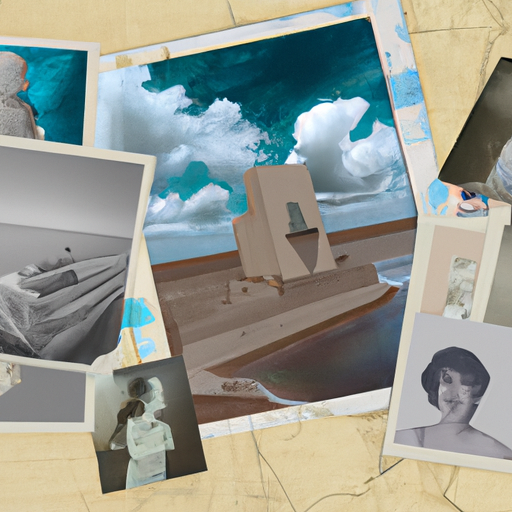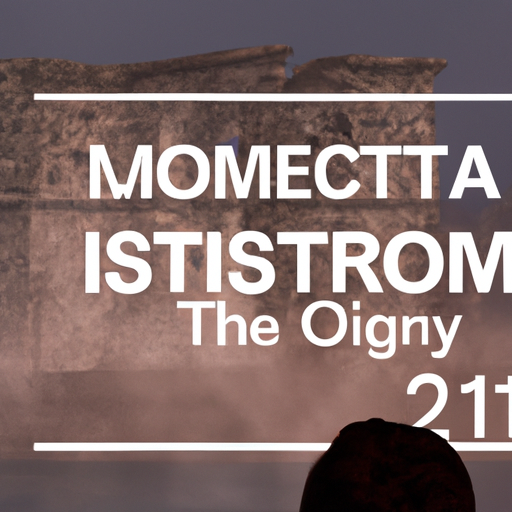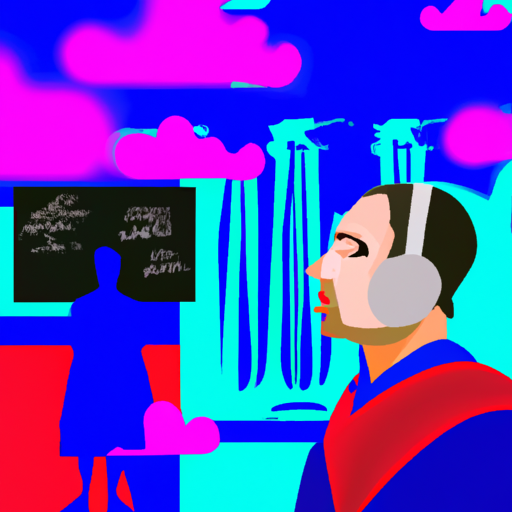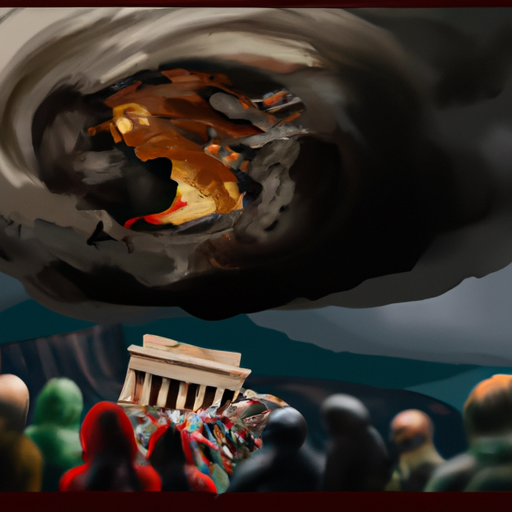Exploring the History of the Viking God Odin
Unearth the mysteries of a bygone era, and unlock the secrets of an ancient pantheon! Delve into the annals of history and explore who was venerated as the divine sovereign of these seafaring warriors. Uncover the truth behind this forgotten faith and discover what made these gods so powerful in their own time. Unearth a culture steeped in mythology and uncover the truth about these mysterious figures worshipped by Vikings!

Plunge into the depths of a forgotten faith, delving into the past of the Viking pantheon. Unearth the secrets of these powerful gods, and explore their importance to a culture steeped in mythology. Learn about the stories and myths that surrounded them, and why they were so revered by seafaring warriors. Gain insight into an era long since gone, yet still felt today – uncovering what made these deities so influential for centuries. Uncover the mysteries of this ancient pantheon, and discover what made it so powerful in its own time.
.
Introduction

Mystical and enigmatic, the ancient Norse peoples were driven by a reverence for a multitude of deities. Odin, otherwise known as Woden or Wotan, was the leader of this pantheon and was held in high esteem as a god of war, knowledge, poesy, and sorcery. It is said he granted humanity with civilization and enlightenment. His wife Frigg was also an influential goddess who personified maternity and fecundity. Other gods venerated by the Vikings included Thor (thunder), Freyr (fertility), Tyr (law/justice), Baldr (beauty) and Loki (mischief).
– Historical Evidence of Viking Gods
Mystery and intrigue have long surrounded the gods of Norse mythology. For centuries, these powerful figures have been an integral part of Scandinavian culture, with many artifacts, texts, and records indicating their presence in this region.
Archaeological discoveries from the 8th century CE have yielded a wealth of evidence to suggest that Viking gods were indeed worshipped throughout Scandinavia. Jewelry, weapons, pottery – all bear witness to the reverence paid to these deities. Ancient runestones also depict scenes from Norse mythology, such as Odin’s eight-legged horse Sleipnir and Thor’s hammer Mjölnir.
The sagas and Eddas provide further insight into these gods’ powers and personalities. The Poetic Edda is particularly noteworthy due to its age; some of its accounts are among the oldest written references to Norse mythology available today.
Moreover, there is evidence that Viking gods were mentioned in other cultures around Europe during the Middle Ages. Records from England indicate Vikings often invoked Odin before battle while Irish texts refer to Thor as “the Thunderer” or “the Destroyer” – suggesting knowledge of these figures was widespread at this time.
Thus it can be seen that there exists a plethora of historical evidence for Viking gods’ existence in Scandinavia and beyond during the Middle Ages – providing us with a greater understanding of their importance in this era.
– Ancient Norse Mythology and its Influence on Viking History
An enigmatic power pervades the annals of Viking history, a force that has been attributed to an age-old source: Norse mythology. It is believed that their gods and goddesses had a great impact on the lives of these seafaring people, particularly in terms of fate and destiny. The nine realms were each presided over by a different deity: Odin was master of Asgard, the abode of the gods; Thor wielded thunder and strength; Freya embodied love and beauty.
The Vikings consulted seers to interpret signs from the gods in order to discover what lay ahead in life. This faith also drove them to be superstitious; they would not sail on Fridays or eat fish during Yule as they were convinced that such actions could bring bad luck. Conversely, if they stayed true to their gods, victory and fortune would be bestowed upon them.
In addition, ancestor worship was highly respected among these ancient people. They believed that their forebears had an influence on their lives so offerings such as food or coins were placed at gravesites as a sign of reverence. This practice may have been one of the reasons why Vikings were so successful in battle – they felt protected by their ancestors.
It is clear that Norse mythology played an essential role in shaping Viking culture through its effects on beliefs about destiny, superstitions, and ancestor worship. By exploring these aspects we can gain invaluable insight into this ancient civilization which eventually faded away with time.
– The Role of Odin in Viking History
Mystery and intrigue surround the figure of Odin in Viking lore. Believed to be the father of all gods and goddesses, he was a powerful presence in Norse mythology, renowned for his prowess on the battlefield, as well as his knowledge and guidance. He was seen as an inspirational force to warriors who would carry symbols associated with him into battle; such as helmets adorned with horns or wings resembling those of an eagle or raven – both animals closely linked to Odin.
Odin was also credited with two sources of magical knowledge – Mímir’s Well and Yggdrasil – which enabled him to impart wisdom upon mortals seeking it out. However, this knowledge came at a price; often involving self-sacrifice or some other form of payment. His power over life and death meant that he held great influence over mortals during their time period; something which could be both terrifying and awe-inspiring.
Even today, Odin’s influence can still be felt; a testament to his impact on Viking culture centuries ago.
– Worship Practices of the Viking Gods Throughout History
Throughout the ages, veneration of the Viking gods has taken many forms. In Norse mythology, these powerful and dangerous entities were appeased with offerings and sacrifices ranging from animals to elaborate ceremonies. During the Viking Age (c. 800-1050 CE), Odin was one of the most important gods worshipped by the Scandinavian people, with devotees making offerings of meat, mead and even human sacrifice in his honor. Ceremonies included singing, dancing and drinking rituals.
As Christianity spread across Scandinavia during the Middle Ages (c. 1050-1300 CE), many pagan practices were abandoned or blended with Christian beliefs; however, some elements remained alive in folk customs and beliefs such as Thor being venerated as a protector against natural disasters like thunderstorms or floods. People would make offerings of food and drink at sacred sites dedicated to Thor or other gods in hopes of gaining divine favor.
In more recent times (c. 1800s-present), interest in Norse mythology has been revived due to its use in literature such as Richard Wagner’s Der Ring des Nibelungen (1876) and JRR Tolkien’s The Lord of the Rings trilogy (1954–55). This has led to a resurgence of pagan religious practices among some individuals who seek to reconnect with their spiritual heritage. Today, organizations like Ásatrúarfélagið focus on honoring the old gods through rituals such as blóts (sacrificial feasts).
The worship practices of the Viking gods have changed over time but remain an integral part of Scandinavian culture today, with people continuing to honor these deities through both ancient and modern rituals in order to gain their favor for protection against life’s challenges.
– Comparative Analysis of Viking and Other Ancient Religions’ Deities
Awe-inspiring gods and goddesses have been adored for ages, with a legacy of ancient religions that still captivates us today. Taking a closer look into these divine figures can provide us with insight into the similarities and discrepancies between these old-world beliefs. Examining their characteristics, domains, and relationships with other deities could help us comprehend how each religion perceived their gods. For instance, Norse mythology has Odin as the leading god while other religions such as Egyptian mythology have numerous gods with diverse functions. We can also compare the roles animals had in different faiths; many cultures used animals as emblems or even sacred creatures themselves. By investigating these components of ancient religions’ deities, we may gain a more profound understanding of our forefathers’ convictions.
conclusion

Mysterious tales of old are told of a culture who sought to honor many gods and goddesses with their reverence. The most prominent among them was Odin, the god of war, wisdom, poetry, and sorcery. Said to be the bringer of death for those who were lost in battle, his power was deeply respected. Others such as Thor, Freya, and Frey also held a place of significance in this ancient religion.
.
Some questions with answers
Q1. Who is the god of Vikings?
A1. The primary god of the Vikings was Odin.
Q2. What is Odin known for?
A2. Odin is known as a god of war, wisdom and death.
Q3. What other gods were worshipped by the Vikings?
A3. Other gods worshipped by the Vikings included Thor, Freyr, and Freyja.
Q4. How did Viking mythology influence their culture?
A4. Viking mythology heavily influenced their culture, including their values and beliefs about honor, courage, loyalty and strength.
Q5. How has Viking history been recorded?
A5. Viking history has been recorded in texts such as the Poetic Edda and Prose Edda, as well as archaeological evidence such as artifacts and rune stones.





